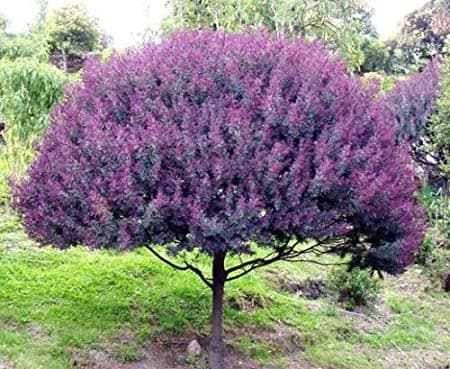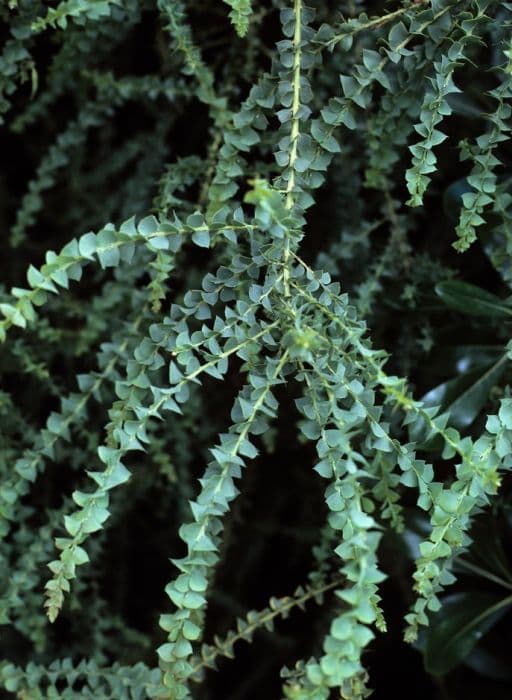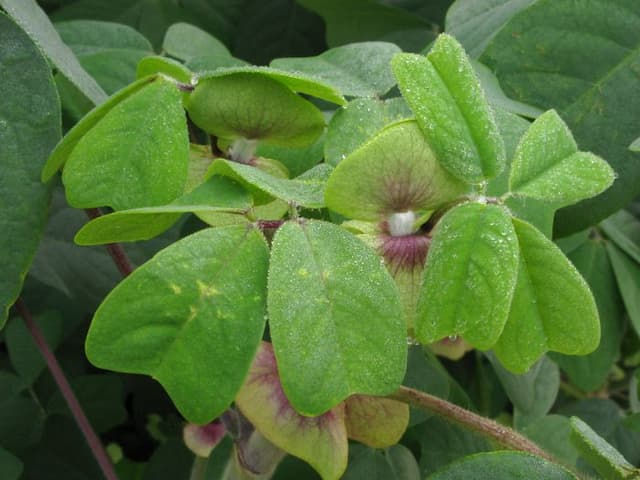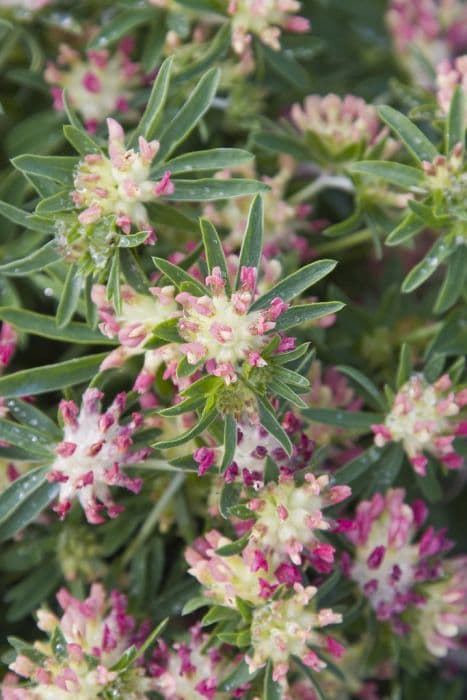Chinese wisteria Wisteria sinensis 'Amethyst'

ABOUT
Wisteria sinensis 'Amethyst', commonly known as Chinese wisteria, is a highly ornamental, deciduous climbing plant that is prized for its enchanting aesthetic. Its appearance is most noted for the striking cascades of fragrant flowers that it puts forth in the spring. These flower clusters are a deep, rich purple, resembling the precious gemstone amethyst in color, and they hang elegantly in long racemes or bunches, creating a dramatic and beautiful display. The foliage of the Chinese wisteria consists of bright green, pinnate leaves, which are compound with multiple leaflets arranged on either side of a central stem. As the seasons change, the leaves may turn to a yellowish hue before falling off in the autumn. The bark on Chinese wisteria is another distinctive feature, becoming dark and gnarled as it ages, which gives the plant character and visual interest even when it is not in bloom. The vine has a twining habit, wrapping itself around any available support. It can be trained on sturdy structures, enabling it to climb and drape in a picturesque manner that is highly sought after for landscape use. Overall, the 'Amethyst' cultivar of Chinese wisteria is a breathtaking climber known most prominently for its profusion of fragrant, show-stopping flowers and a vigorous growth habit that allows it to cloak structures in a blanket of greenery, punctuated by deep purple floral clusters each spring.
About this plant
 Names
NamesFamily
Fabaceae.
Synonyms
Chinese Wisteria, Amethyst Falls Wisteria.
Common names
Rehsonia sinensis, Glycine sinensis, Kraunhia sinensis, Millettia sinensis, Wisteria chinensis.
 Toxicity
ToxicityTo humans
Chinese wisteria, including the variety 'Amethyst', is toxic to humans. The seeds and pods can be particularly poisonous if ingested, containing substances like lectin and wisterin, which can cause gastrointestinal disturbances and other symptoms. Symptoms of poisoning may include nausea, vomiting, stomach pain, diarrhea, and in some cases, dizziness. It is important to avoid eating any part of this plant and to seek medical attention if ingestion occurs.
To pets
Chinese wisteria is also toxic to pets. Ingestion of the seeds, pods, or other plant parts can lead to similar gastrointestinal upset as seen in humans, with symptoms such as vomiting, diarrhea, and abdominal pain. In severe cases, it can also result in depression of the central nervous system. If you suspect your pet has ingested Chinese wisteria, it is important to seek immediate veterinary care.
 Characteristics
CharacteristicsLife cycle
Perennials
Foliage type
Deciduous
Color of leaves
Green
Flower color
Purple
Height
20-30 feet (6-9 meters)
Spread
10-25 feet (3-8 meters)
Plant type
Climber
Hardiness zones
5
Native area
China
Benefits
 General Benefits
General Benefits- Ornamental Value: Wisteria sinensis 'Amethyst' is highly valued for its cascading clusters of fragrant, purple flowers that add aesthetic beauty to gardens and landscapes.
- Shade Provision: The dense foliage provides cool shade, making it ideal for covering arbors, pergolas, or patios.
- Vertical Gardening: As a climbing vine, it allows for vertical gardening, which can save space and create living walls.
- Seasonal Interest: It has a distinct blooming season in spring, adding seasonal interest to the garden with its lush flowers.
- Habitat Support: The flowers can attract pollinators, such as bees and butterflies, supporting local ecosystems.
- Durability: It's known for being hardy and can tolerate a variety of soil types, making it a resilient choice for different garden settings.
- Privacy: When grown on fences or trellises, it can provide privacy screening from neighbors or street view.
- Property Value: By enhancing the landscape with its striking presence, it can potentially increase property value.
- Growth Habit: Its vigorous growth habit can quickly cover unsightly structures or bare walls, providing a quick aesthetic solution.
- Longevity: With proper care, it can live and bloom for many years, offering long-term enjoyment.
 Medical Properties
Medical PropertiesThis plant is not used for medical purposes.
 Air-purifying Qualities
Air-purifying QualitiesThis plant is not specifically known for air purifying qualities.
 Other Uses
Other Uses- Wisteria can be trained to grow over arbors and pergolas to create natural shade in gardens and on patios, thus reducing the need for manufactured shade covers.
- The durable stems of mature Wisteria can be woven into furniture or decorative baskets with a unique twist due to its spiral growth habit.
- With proper care, Wisteria bonsai trees make for a fascinating and intricate addition to any bonsai collection, showcasing the beauty of the plant in miniature form.
- Fallen Wisteria petals can be collected and used as a natural confetti for outdoor celebrations, adding a touch of organic elegance to events.
- When dried, the seed pods of Wisteria can be used in floral arrangements or as part of a rustic decorative piece thanks to their unique velvety texture and appearance.
- Garden designers use the cascading blooms of Wisteria to create picturesque landscapes, often employing them as living backdrops for photo shoots.
- Artists can utilize the color and form of Wisteria blooms in their work, whether through photography, painting, or as inspiration for design and fashion.
- The plant is sometimes incorporated into storytelling or theater productions as a symbol for passionate love or obsession, due to its vigorous growth and clinging nature.
- Wisteria wood, being quite hard when mature, can be used to make small carved items such as ornaments or even tools and is favored for its durability.
- As an alternative to artificial dyes, the flowers of the Wisteria plant can be used to create a natural dye for textiles, offering a range of soft purples and lavenders.
Interesting Facts
 Feng Shui
Feng ShuiThe Chinese Wisteria is not used in Feng Shui practice.
 Zodiac Sign Compitability
Zodiac Sign CompitabilityThe Chinese Wisteria is not used in astrology practice.
 Plant Symbolism
Plant Symbolism- Longevity and Immortality: Wisteria is renowned for its ability to live for a very long time. Some wisteria vines are even hundred years old, representing enduring life and continuous growth.
- Mystery and Sensuality: The captivating and delicate scent of wisteria is often associated with mystery, while the sensuous hanging blossoms symbolize romantic encounters or the sweet intoxication of love.
- Good Luck: In some cultures, such as the Chinese, wisteria is considered a symbol of good luck and is often planted for its auspicious energies.
- Welcoming: Wisteria often adorns the front of homes as its cascading blooms are seen as a sign of a warm and inviting welcome to guests.
- Beauty: The stunning display of wisteria flowers, especially the rich purplish hue of the 'Amethyst' variety, is symbolic of beauty and splendor.
- Release of Burdens: The way wisteria grows, spiraling upwards and releasing its flowers downwards, can symbolize the letting go of past sorrows or burdens and embracing the potential for new growth and opportunity.
 Water
WaterChinese Wisteria 'Amethyst' should be watered deeply but infrequently, ensuring the soil is moist but not waterlogged. During the growing season, water this plant weekly with about one gallon of water per plant, increasing to two gallons in the heat of summer. Reduce watering in the fall and water sparingly in winter, depending on rainfall, to prevent root rot. Soil should be checked for moisture depth of an inch, and watered if it feels dry to the touch. Overhead watering should be avoided as it can promote leaf diseases.
 Light
LightChinese Wisteria 'Amethyst' thrives in full sun to partial shade. For best growth and flower production, plant it in a location where it receives a minimum of six hours of sunlight a day. Avoid deeply shaded areas, as this can reduce blooming and weaken the plant.
 Temperature
TemperatureChinese Wisteria 'Amethyst' is hardy and can withstand a range of temperatures, from about 20°F to 90°F. The ideal temperature range for this plant is between 55°F and 75°F, which encourages robust growth and flowering. It's cold hardy down to at least 20°F but may require protection during extreme temperature drops.
 Pruning
PruningChinese Wisteria 'Amethyst' requires pruning to maintain its shape and encourage flowering. Prune in late winter to remove unwanted growth and again in mid-summer to tidy up long shoots. Pruning is best done twice a year. The optimal time for heavy pruning is late winter before new growth begins.
 Cleaning
CleaningAs needed
 Soil
SoilChinese Wisteria prefers a fertile, well-draining soil mix with a pH of 6.0 to 7.0. A good mix can be created with equal parts loam, peat, and sand to ensure good drainage and fertility.
 Repotting
RepottingChinese Wisteria should be repotted every two to three years or when it becomes root-bound. Young plants may require more frequent repotting to accommodate rapid growth.
 Humidity & Misting
Humidity & MistingChinese Wisteria thrives best in moderate to high humidity levels. While it's adaptable to various conditions, maintaining a relative humidity of around 40-60% is optimal.
 Suitable locations
Suitable locationsIndoor
Provide strong support, ample light, and prune regularly.
Outdoor
Plant in full sun, ensure sturdy support, prune for shape.
Hardiness zone
5-9 USDA
 Life cycle
Life cycleChinese Wisteria 'Amethyst' (Wisteria sinensis 'Amethyst') begins its life as a seed, which germinates in favorable conditions of warmth and moisture. Once the seedling emerges, it develops into a rapidly growing, twining vine, which requires sturdy support to climb. Through its juvenile phase, the plant focuses on vegetative growth, establishing a strong root system and expansive foliage. After a few years, which can range from 3 to 20, Wisteria 'Amethyst' reaches maturity and begins to flower, producing long, pendulous clusters of fragrant, purple flowers in late spring. The plant then enters a reproductive phase annually, where it flowers, develops seed pods, and disperses seeds to continue the life cycle. In absence of disturbance, Chinese Wisteria 'Amethyst' can live for several decades, continuing its cycle of vegetative growth and annual flowering and seed production.
 Propogation
PropogationPropogation time
Spring-Early Summer
Wisteria, specifically the Wisteria sinensis 'Amethyst', can be propagated most successfully through the cuttings method during the summer months when the plant is actively growing. To propagate from cuttings, a gardener should select a healthy, new growth shoot and cut a section approximately 4 to 6 inches (10 to 15 cm) long just below a leaf node. This cutting should then have the lower leaves removed and be dipped in rooting hormone to encourage root development. The treated cutting can be placed in a well-draining soil mix, ideally composed of half peat and half perlite or sand. It is important to maintain a moist environment for the cutting by either misting regularly or covering it with a plastic bag to create a greenhouse effect, until roots have developed and new growth is observed. Once the cutting has established a strong root system, it can be transplanted to a more permanent location outdoors.









